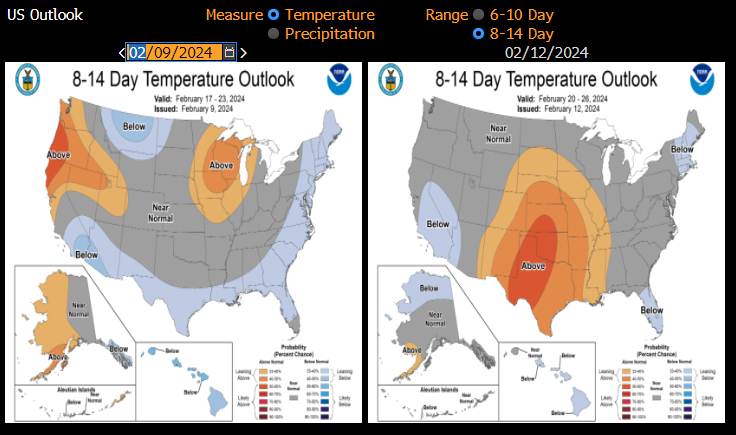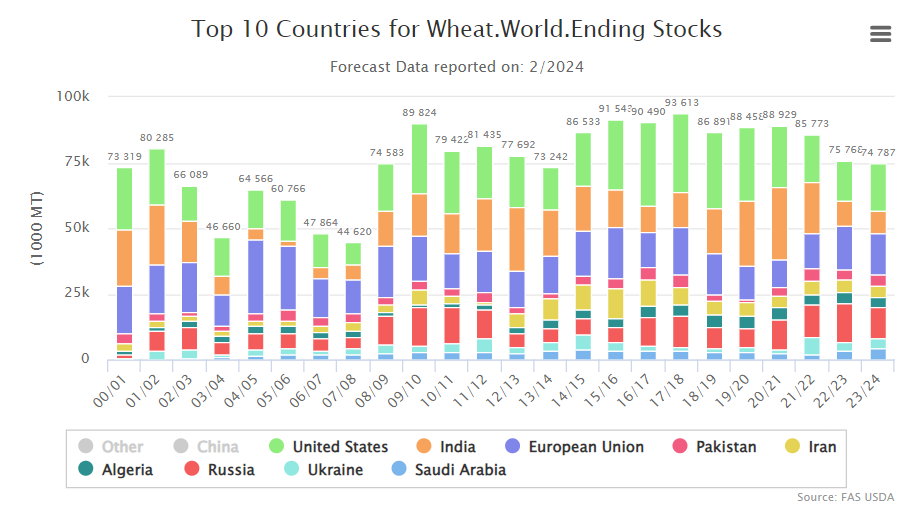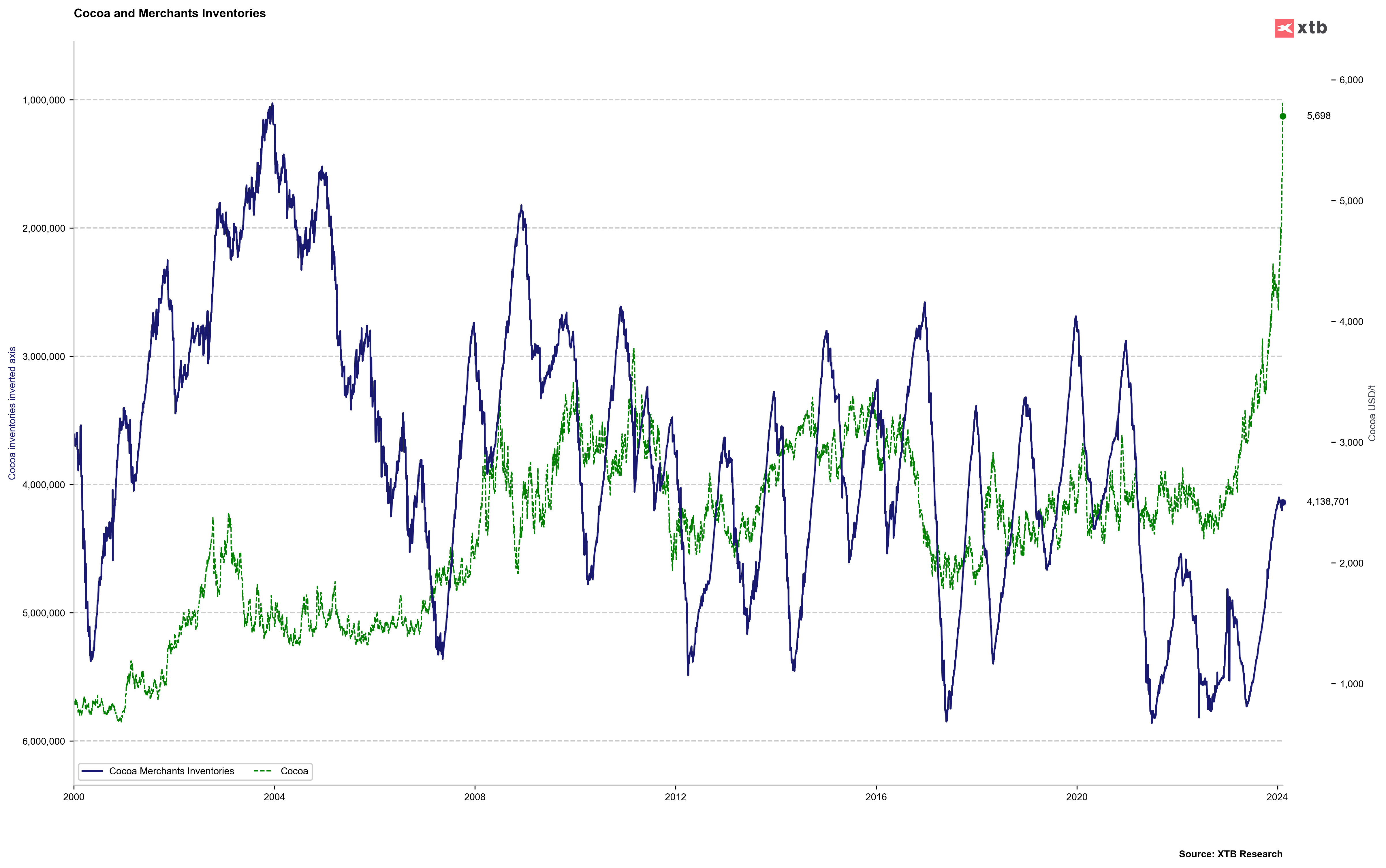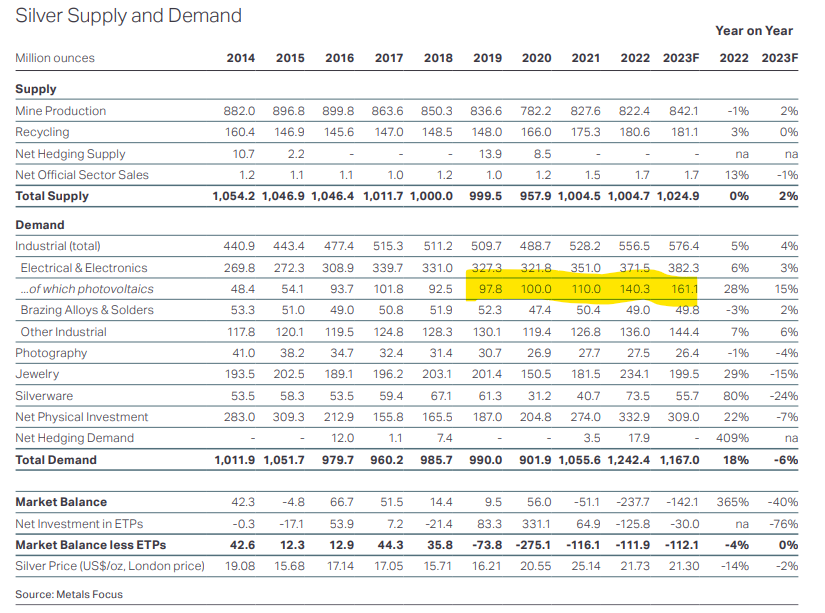Natural Gas (NATGAS):
- Natural gas storage sites in European Union are over 65% full, significantly above 5-year average for the current period of the year
- It is expected that peak heating season in Europe is already behind us and process of refilling storage will begin quickly (heating season is expected to end with storage being over 50% full
- Supply in the United States has stabilized in recent days at around 110 billion cubic feet per day, while demand stood at around 110-125 bcf. This suggests a relatively small drop in inventories. Nevertheless, it is expected that demand may increase to as much as 130 bcf per day in the next few days
- Weather forecasts point to near-average temperatures in the near-term, with slightly above-average temperatures in the central part of the mainland US

Start investing today or test a free demo
Create account Try a demo Download mobile app Download mobile appWeather forecasts hint at stabilization, what suggests small inventory draws in near-term. Source: Bloomberg Finance LP
 Analysing the price of US natural gas on a logarithmic scale and assuming that target of the reversed wave pattern will be reached, the price could potentially drop below $1.00 per MMBTU. However, historical lows over the last 30 years have typically formed between the range of $1.5-2.0 per MMBTU. Seasonal patterns suggest the proximity of a local low, but this is also influenced by the structure of the futures curve, which anticipates a rebound in prices from May to November. It's important to note that there is still room for increase in number of short positions, considering the net positioning. From a positioning perspective, the situation somewhat resembles the year 2019/2020. Back then, the price reached a low slightly above the 161.8% retracement of the preceding upward wave. In such a scenario, one could anticipate a potential drop to even 0.85 USD/MMBTU. However, it's worth observing that the price should find support roughly halfway through the formation of the flag pattern, close to the level of $1.50 per MMBTU, which corresponds to the 127.2% retracement of the last upward wave. Source: xStation5
Analysing the price of US natural gas on a logarithmic scale and assuming that target of the reversed wave pattern will be reached, the price could potentially drop below $1.00 per MMBTU. However, historical lows over the last 30 years have typically formed between the range of $1.5-2.0 per MMBTU. Seasonal patterns suggest the proximity of a local low, but this is also influenced by the structure of the futures curve, which anticipates a rebound in prices from May to November. It's important to note that there is still room for increase in number of short positions, considering the net positioning. From a positioning perspective, the situation somewhat resembles the year 2019/2020. Back then, the price reached a low slightly above the 161.8% retracement of the preceding upward wave. In such a scenario, one could anticipate a potential drop to even 0.85 USD/MMBTU. However, it's worth observing that the price should find support roughly halfway through the formation of the flag pattern, close to the level of $1.50 per MMBTU, which corresponds to the 127.2% retracement of the last upward wave. Source: xStation5
Wheat:
- Russia plans to increase the wheat export volume for the year 2024 to 28 million tons, up from the current plan of 24 million tons. This is a result of filling warehouses after a good harvest season
- Export quotas were initially introduced to curb inflation, and at this point, with an increase in the quota, they do not appear to be restrictive
- The latest WASDE (World Agricultural Supply and Demand Estimates) report showed a clear increase in ending stocks for wheat for the 23/24 season, reaching 658 million bushels, compared to the previous level of 648 million bushels
- At the same time, minimal adjustments were made to global stock expectations, reducing them from 260 million tons to 259.4 million tons, with an anticipated increase to 261.1 million tons
 Wheat inventories in Russia declined in the 2023/24 season, compared to 2022/23 season, but still remain at very high levels. Russia wants to get rid of current inventories before winter wheat harvest begins. This hints at potential price pressure, especially given the latest pick-up in US inventories. Source: USDA
Wheat inventories in Russia declined in the 2023/24 season, compared to 2022/23 season, but still remain at very high levels. Russia wants to get rid of current inventories before winter wheat harvest begins. This hints at potential price pressure, especially given the latest pick-up in US inventories. Source: USDA
 The recent rebound in net positions on wheat has led to a marginal uptick in wheat prices. Volatility in recent weeks has practically stagnated, and it can be expected that the situation will not change due to excessive supply from Russia. It is worth noting that the price behaves very similarly to what happened in the years 2007-2010. On the other hand, in recent years, we have been observing a decreasing global production and continuously growing demand. Therefore, after reaching a local low, there is a significant chance for a similar price rebound, as occurred in 2010 due to a substantial decline in global reserves. Source: xStation5
The recent rebound in net positions on wheat has led to a marginal uptick in wheat prices. Volatility in recent weeks has practically stagnated, and it can be expected that the situation will not change due to excessive supply from Russia. It is worth noting that the price behaves very similarly to what happened in the years 2007-2010. On the other hand, in recent years, we have been observing a decreasing global production and continuously growing demand. Therefore, after reaching a local low, there is a significant chance for a similar price rebound, as occurred in 2010 due to a substantial decline in global reserves. Source: xStation5
Cocoa:
- According to Citi, ongoing supply challenges in West African countries could lead to an increase in cocoa prices to the range of $7,000-$10,000 per ton in the second half of 2025
- The bank points to a price range of $6,000-$6,300 within the next two months if there is no improvement in cocoa supply information
- Currently, Citi's average price forecast for this year is $5,165 per ton, but this level is likely to be revised upward
- Citi suggests that excessive prices may result in a reduction in cocoa demand. Nevertheless, the bank does not anticipate the build-up of short positions in cocoa before April/May
- April/May also marks the beginning of the mid-season. If there is an improvement in production expectations, it could potentially lead to a decline in prices
- The price rose last week to around $5,600 per ton, surpassing the peaks from the 1970s at around $5,300 per ton
- Merchants believe that the tight market conditions will persist for 18 to 36 months
- While current high prices encourage an increase in cultivation area and the number of trees, it takes 3-5 years for them to yield significant harvests
- Poor weather conditions and diseases may hinder the Ivory Coast from meeting contracted cocoa deliveries in the coming months
- Simultaneously, stock levels on exchanges are not extremely low, suggesting a somewhat excessive price increase
- Further price growth will depend on demand prospects, and if they continue to grow in the range of 3-4% annually, price increases may be sustained

Merchant inventories remain at low levels, but are not as extremely low as it was the case in 2003 or 2008-2016. Price gains have been rather limited so far but should the drop in stockpiles accelerate, cocoa prices may follow higher. Source: Bloomberg Finance LP, XTB Research
 Taking a look at prices over the past 30 years, we can see that corrections often occurred after price deviated by 4 standard deviations above the 1-year average. However, prices deviated by as much as 5 standard deviations above the 5-year average. Source: Bloomberg Finance LP, XTB Research
Taking a look at prices over the past 30 years, we can see that corrections often occurred after price deviated by 4 standard deviations above the 1-year average. However, prices deviated by as much as 5 standard deviations above the 5-year average. Source: Bloomberg Finance LP, XTB Research
 Cocoa price begin to stabilize. Seasonal patterns suggest a possibility of a downward correction until mid-March. On the other hand, reduction in net positioning is not progressing as it did during previous large corrections. Source: xStation5
Cocoa price begin to stabilize. Seasonal patterns suggest a possibility of a downward correction until mid-March. On the other hand, reduction in net positioning is not progressing as it did during previous large corrections. Source: xStation5
Silver:
- The price is holding above the key support level of 21.8-22.0 USD/oz
- Simultaneously, the price has returned above the 50-month moving average, indicating potential bullish prospects
- On the other hand, the gold price has retraced for the second consecutive month but has not surpassed the support between 2000 and 2020 USD/oz
- It's worth noting that there is a strong surge in Bitcoin, driven by inflows into cryptocurrency ETF funds
- For precious metals, there are continued outflows from ETF funds. In the case of silver, the amount of silver in ETFs has been reduced by about 2/3 of the increase since the bottom around the turn of 2019/2020
- Deficit for the 2023 year has decreased compared to 2022. Meanwhile, there is still a significant increase in demand from the photovoltaic sector. Another report from the Silver Institute with outlooks for 2024 is set to be published on April 19

The 2023 report indicates a decreasing deficit in the silver market. However, the persistence of a deficit in the coming years could lay the groundwork for a larger price rebound. The significant threat, though, lies in a substantial increase in supply if there is an expansion of mining projects for copper, nickel, and zinc. Silver is mostly extracted as a by-product during the mining of other industrial metals. Source: Silver Institute
 Silver price holds above key support, what bodes well for the potential price rebound in the later part of the year. Source: xStation5
Silver price holds above key support, what bodes well for the potential price rebound in the later part of the year. Source: xStation5
The content of this report has been created by XTB S.A., with its registered office in Warsaw, at Prosta 67, 00-838 Warsaw, Poland, (KRS number 0000217580) and supervised by Polish Supervision Authority ( No. DDM-M-4021-57-1/2005). This material is a marketing communication within the meaning of Art. 24 (3) of Directive 2014/65/EU of the European Parliament and of the Council of 15 May 2014 on markets in financial instruments and amending Directive 2002/92/EC and Directive 2011/61/EU (MiFID II). Marketing communication is not an investment recommendation or information recommending or suggesting an investment strategy within the meaning of Regulation (EU) No 596/2014 of the European Parliament and of the Council of 16 April 2014 on market abuse (market abuse regulation) and repealing Directive 2003/6/EC of the European Parliament and of the Council and Commission Directives 2003/124/EC, 2003/125/EC and 2004/72/EC and Commission Delegated Regulation (EU) 2016/958 of 9 March 2016 supplementing Regulation (EU) No 596/2014 of the European Parliament and of the Council with regard to regulatory technical standards for the technical arrangements for objective presentation of investment recommendations or other information recommending or suggesting an investment strategy and for disclosure of particular interests or indications of conflicts of interest or any other advice, including in the area of investment advisory, within the meaning of the Trading in Financial Instruments Act of 29 July 2005 (i.e. Journal of Laws 2019, item 875, as amended). The marketing communication is prepared with the highest diligence, objectivity, presents the facts known to the author on the date of preparation and is devoid of any evaluation elements. The marketing communication is prepared without considering the client’s needs, his individual financial situation and does not present any investment strategy in any way. The marketing communication does not constitute an offer of sale, offering, subscription, invitation to purchase, advertisement or promotion of any financial instruments. XTB S.A. is not liable for any client’s actions or omissions, in particular for the acquisition or disposal of financial instruments, undertaken on the basis of the information contained in this marketing communication. In the event that the marketing communication contains any information about any results regarding the financial instruments indicated therein, these do not constitute any guarantee or forecast regarding the future results.

